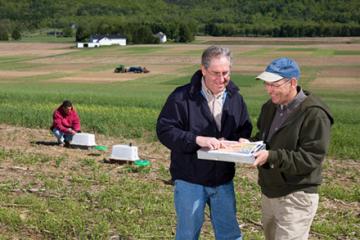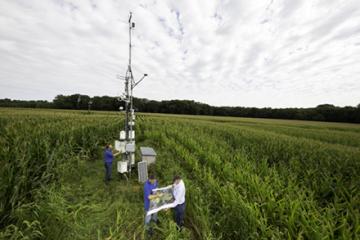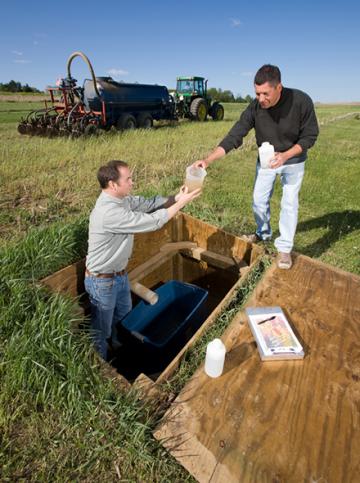Our Planet Earth: Looking to the Future

The purpose of the LTAR network is to provide the nation with a road map for the sustainable intensification of production agriculture, meeting today’s needs and preparing for future changes. At an Upper Chesapeake Bay common experiment site, ARS scientists and university collaborators collect ammonia samples and review plot layouts. (Stephen Ausmus, D1856-11)
Earth Day is a good time to demonstrate support for environmental protection. One thing we can all agree on is that we all want safe and nutritious food to eat, fresh water to drink, and clean air to breathe. Thanks to agriculture, it not only provides us food, but connects life on Earth. Agriculture integrates soil, water, air, and biology to produce food, feed, fiber, and energy. Today, agriculture faces many challenges.
By 2050, the world’s population is expected to grow to more than 9 billion people. This poses a critical challenge to agriculture in our nation and the world. Scientists with the Agricultural Research Service (ARS) play a vital role in protecting our environment by examining approaches and implementing multiple strategies to develop agricultural solutions that are sustainable while meeting the needs of our growing world.
To help meet the needs of our planet, in 2011 ARS created the Long-Term Agroecosystem Research (LTAR) Network—a partnership among 18 premier long-term research sites across the United States. The purpose of the network is to ensure that agriculture is sustainable and capable of providing for our needs now and for generations to come. This involves making sure science addresses enhancing production, protecting the environment, sustaining ecosystem services, and promoting rural prosperity. LTAR’s research will help producers provide agricultural and other ecosystem-related goods and services under changing environmental conditions to meet society's changing demands on natural resources.

At the ARS Henry A. Wallace Beltsville (Maryland) Research Center, one of 18 premier long-term research sites across the United States, scientists review a map of LTAR fields and check data from sensors that monitor carbon dioxide, water vapor, and energy exchanges between the earth’s surface and the atmosphere. (Stephen Ausmus, D3857-1)
Spread across the nation, LTAR sites are located in major watersheds—each with its own unique landscape, environmental influences, and habitat (see more here). The LTAR network represents a diverse set of cropland, grazingland, and integrated systems featuring four linked approaches.
Coordinated Agroecosystem Research – Coordinated research allows scientists to develop and test innovations across the United States, including new genetics, new production techniques, and sensor infrastructure.
Information Management - Data managers and scientists use data portals and visualization tools to help accelerate scientific discoveries and bring real-time management technologies to producers’ hand-held electronic devices.
New Management Technologies and Tools – Linking technologies such as field monitoring, remote sensing, computer models, and web and mobile technologies provide scientists and producers with tools to evaluate the multiple effects of agronomic practices.
Agricultural Innovation Partnerships – Scientists collaborate to promote engagement to understand stakeholder needs and incorporate new science information into practices and technologies that are adopted by producers and accepted by the public.

LTAR’s research guides the sustainable intensification of U.S. agriculture, improving its productivity, minimizing its environmental footprint and contributing to rural prosperity. ARS scientists in LTAR’s Upper Chesapeake Bay region collect runoff samples to quantify benefits from manure management technologies as part of an LTAR common experiment. (Stephen Ausmus, D1858-15)
Agriculture in our nation must respond to intensifying demands for productivity and efficiency, as well as pressures to improve its stewardship of natural resources. Growing global population, changing diets, and greater societal awareness of its effects have created a sense of urgency for improvements in agriculture. This shifts agriculture’s role in delivering ecosystem services beyond food, feed, fiber, and energy production, therefore requiring a comprehensive perspective on where and how U.S. agriculture can be intensified sustainably.
LTAR is an ambitious, state-of-the-art partnership among ARS, universities, federal agencies, and other research organizations to help farmers strengthen agricultural food production and minimize adverse effects on natural resources. Explore the integrated map of the 18 LTAR network sites here or learn more about the goals and accomplishments of the network here.
As we mark 50 years of Earth Day in 2020, let’s remain mindful of our Planet Earth by encouraging health, well-being, comfort, success, and the ability to transfer these amenities to future generations. Happy Earth Day! — By Monica Williams, ARS Office of Communications.
You May Also Like

